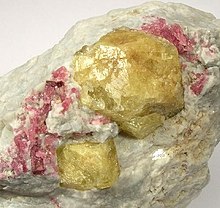


The Borate Minerals are minerals which contain a borate anion group. The borate (BO3) units may be polymerised similar to the SiO4 unit of the silicate mineral class. This results in B2O5, B3O6, B2O4 anions as well as more complex structures which include hydroxideorhalogen anions.[2] The [B(O,OH)4]− anion exists as well.
Many borate minerals, such as borax, colemanite, and ulexite, are salts: soft, readily soluble, and found in evaporite contexts. However, some, such as boracite, are hard and resistant to weathering, more similar to the silicates.
There are over 100 different borate minerals.[2][3] Borate minerals include:
IMA-CNMNC proposes a new hierarchical scheme (Mills et al., 2009). This list uses it to modify the Classification of Nickel–Strunz (mindat.org, 10 ed, pending publication). Note that although Nickel–Strunz division letters were traditionally based on the number of boron atoms in a mineral's chemical formula (06.A are monoborates, 06.B are diborates, etc.), the IMA has reclassified borate minerals based on the polymerisation of the borate anion.
Regarding 03.C Aluminofluorides, 06 Borates, 08 Vanadates (04.H V[5,6] Vanadates), 09 Silicates:
|
| |
|---|---|
| "Special cases" ("native elements and organic minerals") |
|
| "Sulfides and oxides" |
|
| "Evaporites and similars" |
|
| "Mineral structures with tetrahedral units" (sulfate anion, phosphate anion, silicon, etc.) |
|